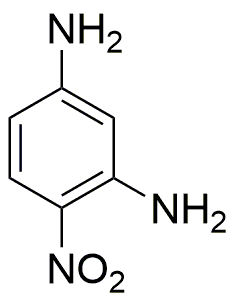4-Nitro-1,3-phenylenediamine is widely utilized in research focused on:
- Dye Manufacturing: This compound is a key intermediate in the production of azo dyes, which are used in textiles and food coloring. Its ability to form vibrant colors makes it essential for the dye industry.
- Pharmaceutical Development: It serves as a building block in the synthesis of various pharmaceuticals, particularly those targeting cancer and other diseases, due to its potential biological activity.
- Polymer Chemistry: Used in the formulation of polymers, it enhances properties such as thermal stability and color retention, making it valuable in plastics and coatings.
- Analytical Chemistry: This compound is employed as a reagent in analytical methods, such as spectrophotometry, to detect and quantify other substances, aiding in quality control processes.
- Research in Material Science: Its unique chemical properties allow for the development of advanced materials, including conductive polymers and sensors, which are crucial in electronics and environmental monitoring.
General Information
Properties
Safety and Regulations
Applications
4-Nitro-1,3-phenylenediamine is widely utilized in research focused on:
- Dye Manufacturing: This compound is a key intermediate in the production of azo dyes, which are used in textiles and food coloring. Its ability to form vibrant colors makes it essential for the dye industry.
- Pharmaceutical Development: It serves as a building block in the synthesis of various pharmaceuticals, particularly those targeting cancer and other diseases, due to its potential biological activity.
- Polymer Chemistry: Used in the formulation of polymers, it enhances properties such as thermal stability and color retention, making it valuable in plastics and coatings.
- Analytical Chemistry: This compound is employed as a reagent in analytical methods, such as spectrophotometry, to detect and quantify other substances, aiding in quality control processes.
- Research in Material Science: Its unique chemical properties allow for the development of advanced materials, including conductive polymers and sensors, which are crucial in electronics and environmental monitoring.
Documents
Safety Data Sheets (SDS)
The SDS provides comprehensive safety information on handling, storage, and disposal of the product.
Product Specification (PS)
The PS provides a comprehensive breakdown of the product’s properties, including chemical composition, physical state, purity, and storage requirements. It also details acceptable quality ranges and the product's intended applications.
Certificates of Analysis (COA)
Search for Certificates of Analysis (COA) by entering the products Lot Number. Lot and Batch Numbers can be found on a product’s label following the words ‘Lot’ or ‘Batch’.
Numéro de catalogue
Numéro de lot/série
Certificates Of Origin (COO)
This COO confirms the country where the product was manufactured, and also details the materials and components used in it and whether it is derived from natural, synthetic, or other specific sources. This certificate may be required for customs, trade, and regulatory compliance.
Numéro de catalogue
Numéro de lot/série
Safety Data Sheets (SDS)
The SDS provides comprehensive safety information on handling, storage, and disposal of the product.
DownloadProduct Specification (PS)
The PS provides a comprehensive breakdown of the product’s properties, including chemical composition, physical state, purity, and storage requirements. It also details acceptable quality ranges and the product's intended applications.
DownloadCertificates of Analysis (COA)
Search for Certificates of Analysis (COA) by entering the products Lot Number. Lot and Batch Numbers can be found on a product’s label following the words ‘Lot’ or ‘Batch’.
Numéro de catalogue
Numéro de lot/série
Certificates Of Origin (COO)
This COO confirms the country where the product was manufactured, and also details the materials and components used in it and whether it is derived from natural, synthetic, or other specific sources. This certificate may be required for customs, trade, and regulatory compliance.


